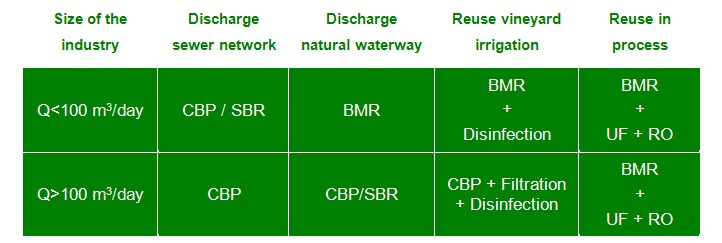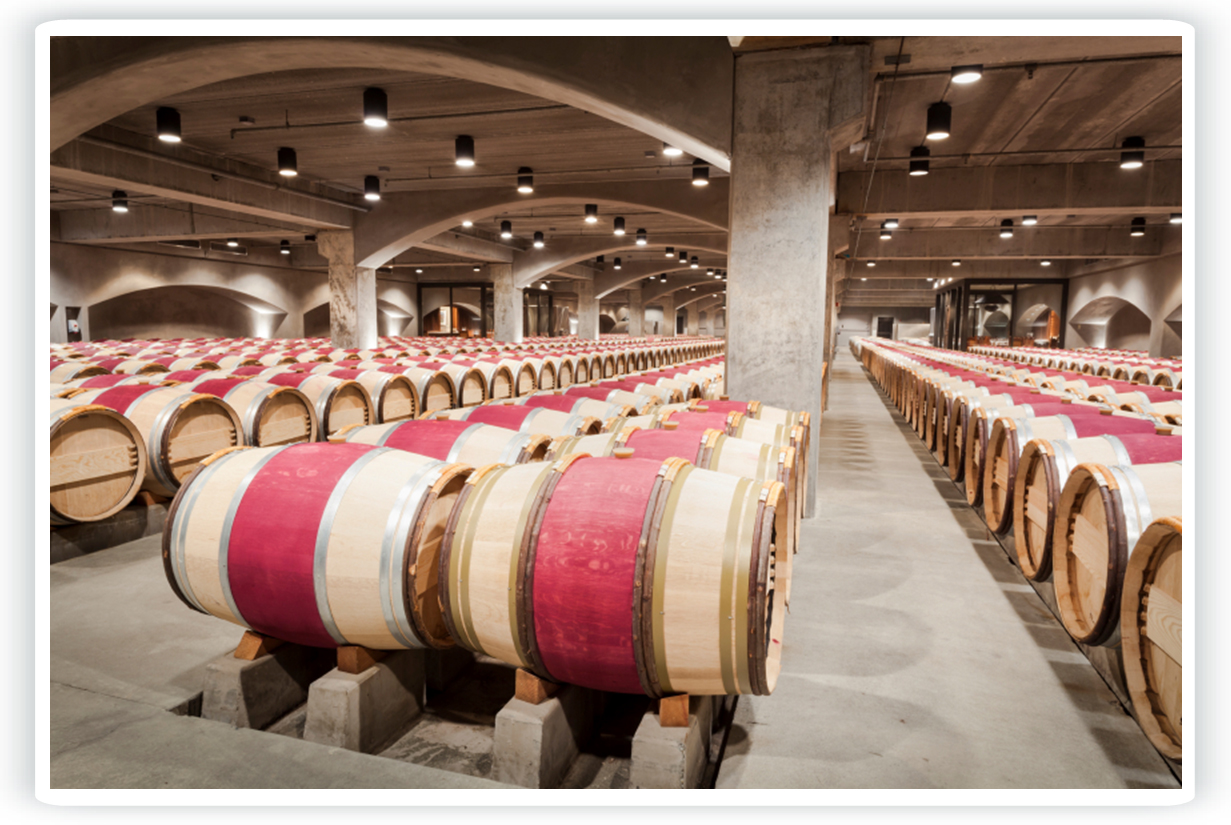Although the number of wine-growing regions increases year after year, only 10 countries produce 80% of the wine on the planet. Indeed, France, Italy and Spain together produce almost 50% of all wine worldwide. The list of the 10 largest wine-producing regions in the world is completed, in this order, by the USA, Chile, Argentina, Australia, South Africa, Germany and Portugal.
Wine production also generates waste and a high volume of wastewater. Wine industry wastewater is mainly produced when cleaning the equipment and machinery that comes into contact with the raw materials or with the products used in the different processes (tanks, presses, reception hoppers, destemmers, pumps, tubing, filters, etc.), washing the fermentation tanks, barrels and bottles and the accidental spillages that occur during the numerous transfers performed as part of the wine-making process.
The quantity and characteristics of the effluents produced differ between harvesting, cellaring and bottling.
- Harvesting: around half of all the wastewater produced throughout the year is generated during this period, which usually lasts for between 2 and 6 weeks. In addition, this wastewater also has the highest contaminant burden. It is generated after pressing of the grapes, upon cleaning the equipment used and as a result of accidental spillages. The COD for this effluent is of the order of 20,000-25,000 mg O2/L.
- Cellaring: wastewater is generated during maturation of the wine upon cleaning the fermentation tanks. In addition, the wine is clarified cold prior to bottling and the sediments separated are usually concentrated by filtration or centrifugation, thereby generating a solid waste and a liquid effluent. Similarly, wastewater is generated when the potassium bitartrate crystals adhered to the walls of the tanks are cleaned using caustic soda. These effluents have a very high pH.
- Bottling: wastewater is generated during this process upon washing the bottles and during cleaning and disinfection of the circuits and equipment at the start and finish of each working day. This wastewater has the lowest contaminant burden.
The effluents generated in this type of industry contain a high contaminant burden, thus meaning that they cannot be discharged without appropriate prior treatment. In general they contain a high organic burden (COD of 6,000-12,000 mg O2/L) due to ethanol, organic acids and/or sugars, an acid pH (between 4.5 and 5.5), are nutrient (nitrogen and phosphorus)-deficient, have moderate concentrations of solids in suspension and contain compounds such as polyphenols, tartrates, etc. With the exception of polyphenols, most of these compounds are readily biodegradable.
As this wastewater is produced by washing processes and accidental spillages during transfer, etc., their production and characteristics vary considerably with time of year and the operation that generates the spillage. As such, the effluent from this type of industry is highly seasonal and variable in terms of both flow and composition.
Given these characteristics of wastewater production in wineries, when deciding which type of treatment is the most appropriate, it should be noted that the first step should be analysis of the different effluents concerned on an individual basis to evaluate how their production can be decreased. Indeed, depending on various factors, such as the size of the facilities, production, cleaning methods and cost, etc. wine making consumes between 1 and 6 liters of water for every liter of wine produced. Consequently, the highest possible reduction in the flows generated (minimizing accidental spillages, implementing dry cleaning whenever possible, performing high-pressure cleaning when dry cleaning is impossible, etc.) is key to minimizing the operating costs of the wastewater treatment system.
The type of wastewater treatment in a winery will depend on the quality required for the treated water, which itself will depend on whether it is discharged into the public sewer network, into a natural waterway or whether it is to be reused in the process or to irrigate the vineyard. The steps would be as follows in increasing order of treatment complexity:
Pretreatment and neutralization
The solids contained in the wastewater are separated in this step as they may hinder the subsequent treatment process as a result of their size. The pH is also adjusted to ensure that the effluent can either be treated or discharged into the public sewer network if the appropriate conditions are met.
Primary treatment
A significant part of the organic matter (around 30-40%) is eliminated in this step upon separation of most of the suspended solids. These solids can be separated by natural decantation or by precipitation in coagulation/flocculation processes.
Secondary treatment
The organic matter and nutrients dissolved in the wastewater are removed in this step. The most suitable process will depend on the flow to be treated and the quality of the treated effluent, which itself will depend on its destination. The type of system that would be most appropriate depending on each of these factors is summarized in the table. Irrespective of the system selected, a water line and a sludge line will be available. The water line will basically comprise the biological reactor and the steps prior to it, whereas a thickening step and, subsequently, a dehydration step should be present in the sludge line.
It should be noted that addition of nitrogen (urea) and phosphorus sources (ammonium phosphate) will be required for the biological process to proceed correctly as this wastewater contains an unbalanced proportion of carbon, nitrogen and phosphorus for microorganism growth.
Advanced treatments
If the effluent from the secondary treatment is to be reused to irrigate the vineyard, it must be disinfected beforehand. The types of disinfection most compatible with the subsequent uses of this water are ozone-based oxidation and ultraviolet radiation. In contrast, a more complete treatment will be necessary if the water is to be reused in the process itself to improve its quality. The effluent from the secondary treatment must be filtered (using a granular sand bed or similar) as a pretreatment process prior to a membrane-filtration process, generally ultrafiltration, followed by reverse osmosis. The quality of the reverse osmosis permeate is excellent and allows any use within the wine-making process.
One technology that is still in development but which could provide excellent economic results comprises inducing fermentation in the wastewater to transform all the sugars present into ethanol, which can be separated by a vacuum concentration/evaporation process. The ethanol separated represents around 85% of the initial COD. This process provides ethanol, a recoverable by-product, and partially decontaminated wastewater with a COD of around 250-300 mg O2/L. This reduction in COD represents a considerable decrease in the amount of oxygen that must be provided in the biological process, thus resulting in significant cost savings.
Consequently, and considering that most wastewater is generated as a result of washing processes, good practices must be applied to reduce the volume produced as far as possible. Generally speaking, wastewater must be treated using a biological process to eliminate the high organic burden contained in it. The type of process, and whether a tertiary treatment must also be added, will to a large extent depend on the destination of the treated water, in other words whether it will be discharged into the public sewer network, into a natural watercourse, reused for irrigation or even used again in the same process.

Q: flow rate (m3/day); CBP: conventional biological process; SBR: sequential batch reactor; BMR: biomembrane reactor; UF: ultrafiltration; RO: Reverse osmosis.
